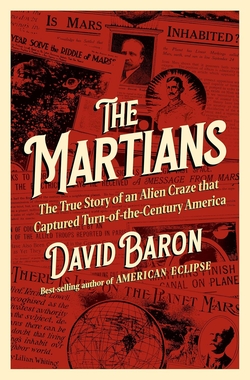Centauri Dreams
Imagining and Planning Interstellar Exploration
Asteroid Bennu: Changes in Rotation Rate
Tuesday’s post on asteroids and what it would take to deflect or destroy one has been usefully reinforced by a new paper from Mike Nolan (Lunar and Planetary Laboratory, University of Arizona) and colleagues, who discuss their findings in Geophysical Research Letters. Here we’re looking at observations of the near-Earth asteroid (101955) Bennu, both archival (extending back to 1999) and current, drawing on the OSIRIS-REx mission.
You’ll recall that OSIRIS-REx (Origins, Spectral Interpretation, Resource Identification, and Security–Regolith Explorer) is in operation around the asteroid, its observations helping us understand the object’s rotation, structure and composition, with a sample return planned for 2023. The Nolan paper fills us in on observed changes in rotation, which are apparent on the order of about 1 second per century. The asteroid’s rotation is speeding up.
Exactly what’s going on here is something we can hope OSIRIS-REx can help nail down. One possibility is a process like the Yarkovsky?O’Keefe?Radzievskii?Paddack effect (YORP), by which asteroids are known to be affected because of the uneven distribution of solar heating across their surfaces. The effects of YORP depend on the shape and orientation of the individual asteroid and can cause either a slowdown or uptick in the object’s spin rate.
Or are there other processes at work here? Even boulders on the surface and their relative positions can play into changes in asteroid spin. It’s important to find out because over astronomical time periods, a faster spinning asteroid could eventually shed some of its mass. One thing, then, that OSIRIS-REx will be looking for is the presence of landslides or other surface evidence of such changes. Nolan points to the possibilities:
“As it speeds up, things ought to change, and so we’re going to be looking for those things and detecting this speed up gives us some clues as to the kinds of things we should be looking for. We should be looking for evidence that something was different in the fairly recent past and it’s conceivable things may be changing as we go.”
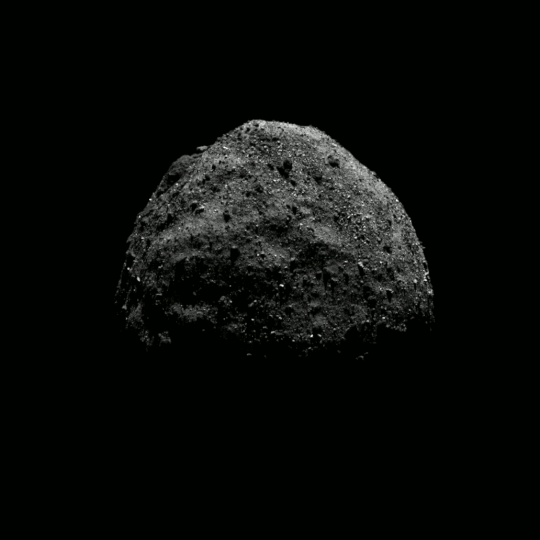
Image: This series of MapCam images was taken over the course of about four hours and 19 minutes on Dec. 4, 2018, as OSIRIS-REx made its first pass over Bennu’s north pole. The images were captured as the spacecraft was inbound toward Bennu, shortly before its closest approach of the asteroid’s pole. As the asteroid rotates and grows larger in the field of view, the range to the center of Bennu shrinks from about 11.4 to 9.3 km (7.1 to 5.8 miles). This first pass was one of five flyovers of Bennu’s poles and equator that OSIRIS-REx conducted during its Preliminary Survey of the asteroid. Credit: NASA/Goddard/University of Arizona.
We’re fortunate in having data from ground-based telescopes as well as Hubble to study the object over time. 110 million kilometers from Earth, the spinning Bennu completes a full rotation every 4.3 hours. The Hubble data on rotation rate showed a slight mismatch with the predictions of the earlier observations. And while Nolan and team point out that a change in the asteroid’s shape could account for its change in rotation, they clearly favor the YORP hypothesis. Having OSIRIS-REx at Bennu offers the opportunity to put YORP ideas to a close-up test.
The increase in Bennu’s rotation over the past two decades does not fit some earlier analyses of the YORP effect, making the spacecraft’s work all the more important. As the paper notes:
The OSIRIS-REx science team will independently measure the rotational acceleration during its 2-years of proximity operations. The precise shape determination, surface boulder distribution, gravity measurements, and thermal property determinations will allow for a better connection between the dominant drivers of the YORP effect (if confirmed) and their relative importance. The OSIRIS-REx team can measure the stability of the rotation state, to confirm whether this acceleration is a steady increase due to the YORP effect, or some other (likely episodic) process such as mass movement. Thus, our observations form a critical baseline for future work.
Within two years, we should have the OSIRIS-REx data independently providing Bennu’s rotation rate, which should help to identify the cause. We’ll also be looking at Bennu with other instruments for the next several decades to see whether further changes in rotation rate, consistent with YORP or not, emerge. Usefully, work like this allows us to compare and contrast in situ measurements with ground-based observations, giving us the chance to hone our skills at asteroid analysis for application to the larger population.
The paper is Nolan et al., “Detection of Rotational Acceleration of Bennu Using HST Light Curve Observations,” Geophysical Research Letters 31 January 2019 (abstract).

A Biosignature Plus for K-Class Stars
Kepler-62 is a reminder of how interesting K-class stars (like Alpha Centauri B) can be. Here we find two worlds that are conceivably in the habitable zone of their star, with Kepler 62f, imagined in the image below, orbiting the host star every 267 days. Kepler-62e, the bright object depicted to the right of the planet, may orbit within the inner edge of the habitable zone. Both planets are larger than Earth, Kepler 62f about 40 percent so, while Kepler-62e is 60 percent larger.
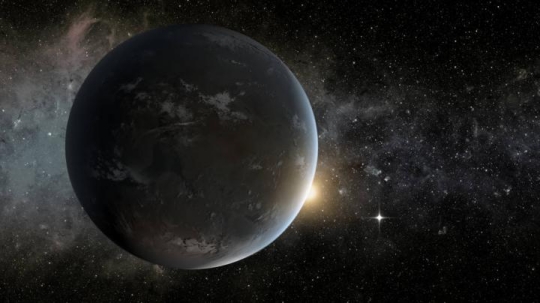
Image: The artist’s concept depicts Kepler-62f, a super-Earth-size planet in the habitable zone of a star smaller and cooler than the sun, located about 1,200 light-years from Earth in the constellation Lyra. Credit: NASA Ames/JPL-Caltech/Tim Pyle.
We actually have five planets here, all known thanks to Kepler to transit their star. The two of habitable zone interest may or may not be solid planets — their masses are not well constrained through either radial velocity or transit timing methods, so we are a long way from knowing whether life might actually form on either. Kepler-62e may well turn out to be a gaseous mini-Neptune, based on its radius. As for the host, Kepler-62 is a K-class main sequence star approximately 70 percent the mass of the Sun, and about 7 billion years old.
K-class stars, particularly those closer than Kepler-62, are seeing a flurry of interest as potential homes for life. In fact, Giada Arney (NASA GSFC) sees them as “in a ‘sweet spot’ between Sun-analog stars and M stars,” for reasons that become clear when you compare them to their smaller and cooler cousins. M-dwarfs are ubiquitous, comprising perhaps 80 percent of all stars in the galaxy, but they’re also given to severe flare activity especially in their early years, enough so that there is a real possibility of damage to the atmosphere and loss of liquid water on the surface.
Add to this problems like tidal locking that could afflict planets in the close-in habitable zone around a cool M-dwarf and by comparison, K-class stars have particular advantages. Arney’s analysis of K star habitability and biosignatures appears in Astrophysical Journal Letters, and it makes the case that a biosignature like the simultaneous presence of oxygen and methane will likely be stronger around a K star than a star like the Sun.
To examine the issue, the scientist developed a computer model simulating planetary atmospheres that could be subjected to conditions around a variety of host stars. Simulations of planetary spectra from these atmospheres could then be produced for analysis. Arney’s work shows that a habitable zone planet circling a K star is one that allows methane to build up in the atmosphere because the host star’s ultraviolet does not generate the highly reactive oxygen that destroys methane as quickly as a star like the Sun. With methane lasting longer within an oxygenated atmosphere, our chance of detecting disequilibrium between the gases increases.
We can add in another factor (one that also favors M-dwarfs): The contrast in brightness between the Sun and our Earth would, to a distant observer, be about 10 billion times, making Earth a very tricky world to observe. Whereas the contrast between a habitable zone planet and a K star is closer to 1 billion. That makes nearby K stars interesting places for future biosignature searches, allowing shorter observing times to achieve a given signal to noise ratio. The author thinks we should keep these advantages in mind as we plan future exoplanet observatories.
The paper lists some interesting targets:
These simulations suggest that nearby mid-to-late K dwarfs such as 61 Cyg A, and 61 Cyg B, Epsilon Indi, Groombridge 1618, and HD 156026 may be particularly excellent targets for biosignature searches on exoplanets. In addition to the “K dwarf advantage” for biosignatures, these stars can offer access to a wide range of wavelengths for HZ planets even with IWA [Inner Working Angle] constraints. 61 Cyg A, 61 Cyg B, Epsilon Indi, and Groombridge 1618 provide higher or comparable S/N to Tau Ceti, the closest G dwarf other than the Sun and Proxima Centauri A. In particular, 61 Cyg A and 61 Cyg B, which are at a similar distance as Tau Ceti (3.6 pc), offer S/N that is 1.6-1.7 times better in the same integration time. HD 156026 is at a similar distance as 82 Eridani (6 pc), and it offers 1.4 times better S/N compared to this G6V star.
But there is this challenge, as alluded to above: Habitable zone planets around K stars will orbit closer to their host than comparable planets around G-class stars like the Sun. That could mean that such planets fall inside the Inner Working Angle (IWA) of future observatories. The IWA defines the smallest separation between planet and star at which the planet can be resolved. Direct imaging telescopes, including the future LUVOIR and HabEx may not, then, be able to see the planet at the needed wavelengths. The paper considers starshade and coronagraph designs that could solve this problem.
The paper is Arney, “The K Dwarf Advantage for Biosignatures on Directly Imaged Exoplanets,” Astrophysical Journal Letters Vol. 873, No. 1 (6 March 2019). Abstract / full text.

Asteroids in Collision: A New Model
If we were to find an asteroid on a trajectory to impact the Earth, what strategies would we use to stop it? Recent work from Johns Hopkins University shows that there is a wide range in our thinking on what happens to asteroids under various mitigation scenarios. Much depends, of course, on the asteroid’s composition, which we must account for in our models. A good thing, then, that we are supplementing those models with sampling missions like OSIRIS-REx and Hayabusa-2.
Let’s look at the JHU work, though, which updates earlier results from Patrick Michel and colleagues, reported in a 2013 paper; the latter had considered the 5 km/s head-on impact of a 1.21 km diameter basalt impactor on a 25 km diameter target asteroid, with a model varying mass, temperature and material brittleness. Michel’s work showed evidence that the asteroid being targeted would be completely destroyed by the impactor. What Charles El Mir and colleagues at Johns Hopkins have been able to show is that other outcomes are likely.
“We used to believe that the larger the object, the more easily it would break, because bigger objects are more likely to have flaws,” says El Mir. “Our findings, however, show that asteroids are stronger than we used to think and require more energy to be completely shattered.”
Using essentially the same scenario as Michel, El Mir, K. T. Ramesh (JHU) and Derek Richardson (University of Maryland) have created a new model that offers a more detailed look at the smaller-scale processes that take place during such a collision. “Our question was, how much energy does it take to actually destroy an asteroid and break it into pieces?” adds El Mir.
Discussing methods, the authors note their model’s calculation of the first tens of seconds following impact, with transition to computer code integrating longer-term effects. From the paper:
The multi-physics material model is centered around the growth mechanism of an initial distribution of subscale flaws. Rate effects in the model are a natural outcome of the limited crack growth speed, which is explicitly computed based on the local stress state. In addition, porosity growth, pore compaction, and granular flow of highly damaged materials are captured at the material-point level. We validated the model’s predictive capability by comparing the dynamic tensile strength with high-strain-rate Brazilian disk experiments performed on basalt samples.

Image: A frame-by-frame showing how gravity causes asteroid fragments to reaccumulate in the hours following impact. Credit: Charles El Mir/Johns Hopkins University.
The first phase of the scenario is shown in the video below, available at https://www.youtube.com/watch?time_continue=1&v=Vt_xwQYafOY for email subscribers who would like to follow it up in their browsers. What emerges is that millions of cracks form in the asteroid as the crater is created, with the asteroid surviving the hit rather than being shattered, while the surviving core then has sufficient gravitational pull to act on the fragments swirling around it.
In the second phase, available at https://www.youtube.com/watch?time_continue=1&v=ZjBgljnCtWk, what we have left is not a rubble pile held loosely by gravity, but rather a surviving core whose fragments have been redistributed. Can we, then, hope to break an asteroid into small pieces, or is it best to find ways to nudge the entire object onto a new trajectory? The latter still involves the question of asteroid survivability, as we need to move it without breaking it into smaller impactors.
The paper shows the capability of the parent asteroid to withstand huge shock:
The collision imparted substantial damage onto the target, with most of the damage localized under the impact site, resulting in a heavily fractured but not fully damaged “core”. The material points were then converted into soft spheres and handed over to pkdgrav [the modeling software] in a self-consistent manner to calculate the gravitational interaction of the ejected material. We observed substantial ejecta fallback onto the largest remnant of the parent body, with a recovered mass of the largest remnant being 0.85 that of the parent body, indicating that the disruption thresholds for such targets may be higher than previously thought.
Thinking ahead to asteroid mitigation strategies is simple prudence, and requires continuing study of how asteroids respond to the various methods now under consideration to destroy them or change their trajectory. This paper gives us a glimpse of the changing parameters of research on the matter, a window into the ongoing analysis that will refine our planning.
The paper is El Mir et al., “A new hybrid framework for simulating hypervelocity asteroid impacts and gravitational reaccumulation,” Icarus Vol. 321 (15 March 2019), pp. 1013-1025 (abstract). The Michel paper is “Collision and gravitational reaccumulation: Possible formation mechanism of the asteroid Itokawa,” Astronomy & Astrophysics 554, L1 (abstract).

A Sparse Population of Small Kuiper Belt Objects?
One problem with learning about the Kuiper Belt is that objects out there are small and details from Earth-based imaging all too sparse. New Horizons yielded up a world of wonders with Pluto, showing us nitrogen glaciers, and mountains fully 4 kilometers tall. But even relative proximity doesn’t help us in some areas. Pluto’s surface has seen enough geologic activity that evidence of its impact history is sparse. Where to turn to learn what has hit it, and when?
The large moon Charon may provide some answers. Unlike Pluto, its surface is relatively stable, giving us insights deep into the past. And we learn from a new paper by Kelsi Singer (SwRI) that there is a surprising lack of craters here nonetheless. The craters we do see on the two worlds were, according to the paper, formed by objects with diameters ranging from ~40 kilometers to ~300 meters, making them smaller than most KBOs we can observe with our telescopes.
Thus a measure of how much in the dark we are about the nature of KBOs. Even Pluto, with resurfacing at work through geological processes, should show more signs of small craters of 13 kilometers or less in diameter. Their lack seems to make small KBOs — ≲1 to 2 kilometers in diameter — very sparse. The work, which appears in Science, implies that there are major differences between the Kuiper Belt and the closest analogue in our system, the main asteroid belt. Says Singer:
“This surprising lack of small KBOs changes our view of the Kuiper Belt and shows that either its formation or evolution, or both, were somewhat different than those of the asteroid belt between Mars and Jupiter. Perhaps the asteroid belt has more small bodies than the Kuiper Belt because its population experiences more collisions that break up larger objects into smaller ones.”
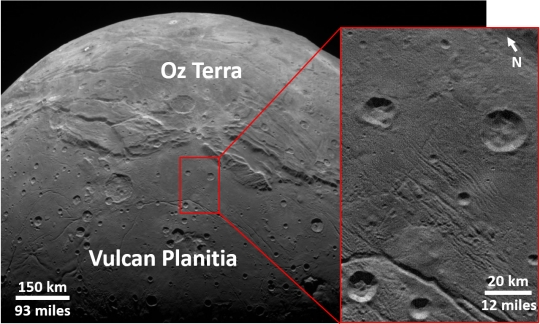
Image: An SwRI-led team studied the craters and geology on Pluto and Charon and found there were fewer small craters than expected. This implies that the Kuiper Belt contains relatively small numbers of objects less than 1.6 kilometers in diameter. Imaged by New Horizon’s LORRI camera, the smooth, geologically stable “Vulcan Planitia” on Charon illustrates these findings. Credit: Courtesy of NASA/JHU/LORRI/SwRI.
We’re still early in the analysis of data from the Ultima Thule flyby, so we don’t want to read too much into this, but it does appear that Ultima supports the same lack of cratering. That’s intriguing because we’re dealing with formation models of the Solar System, which can produce different outcomes and hence populations of objects depending on their inputs. We’re thus homing in on information about the early formation of the Solar System as we analyze the differences between the two belts of debris in their respective positions around the Sun.
Sorting this out will be a lengthy process, dependent upon leveraging data on the three surfaces we’ve been able to study up close through New Horizons, and future data from continued observation (and, let’s assume, additional space missions, including a New Horizons flyby in a future extended mission). Remember that some of the surfaces we’ve seen on Pluto and Charon are likely to be over 4 billion years old, making this analysis of the size and frequency distribution of KBOs provocative.
Interestingly, the paper speculates that if the lack of smaller KBOs is primordial (as opposed to being the result of, say, structural properties of KBOs themselves), this may be consistent with “dynamical models of gravitational instabilities causing rapid growth to larger objects.” Such models produce fewer small bodies and fewer collisions overall. The paper concludes:
There may be more than one combination of processes that can produce the observed KBO SFD [size-frequency distribution]. If there are fewer small objects in the outer Solar System, the probability of collisions is lower, and comets such as 67P/Churyumov-Gerasimenko are less likely to be affected by many catastrophic collisions throughout their lifetimes… By providing constraints on a size range of KBOs not currently accessible by telescopes, the New Horizons crater data can help discriminate between models of accretion, evolution, and/or emplacement of the Kuiper belt.
And dropping back to 1990, we might note another surface, this one of a likely captured KBO, that we viewed from Voyager. I’m pointing to a paper from Robert Strom (Lunar and Planetary Laboratory, University of Arizona) and colleagues on impact cratering on Neptune’s large moon Triton. The scientists found few impact craters on Triton thanks to recent resurfacing from icy melts, with the most heavily cratered surfaces, found on the leading hemisphere in Triton’s orbit, having a crater density about the same as the lunar maria. The scientists argue that some of the craters in Triton’s so-called ‘cantaloupe’ terrain may well be the result of volcanic activity.
The paper is Singer et al., “Impact craters on Pluto and Charon indicate a deficit of small Kuiper Belt objects,” Science Vol. 363, Issue 6430 (01 March 2019), pp. 955-959 (abstract). The Strom paper is “The Impact Cratering Record on Triton,” Science Vol. 250, Issue 4979 (19 October 1990), pp. 437-439 (abstract).

Confirming Kepler-1658b: Tight Orbit around an Evolved Star
A planet designated Kepler-1658b is, after a good deal of investigation, demonstrated to be a ‘hot Jupiter,’ orbiting a star that is 50 percent more massive and three times larger than the Sun. The sizzling world is close enough to its star that were you to look into its sky from near the planet, the star would be 60 times larger than the Sun as seen from Earth. And while none of this makes Kepler-1658b unique in our catalog, what does stand out is how we learned all this.
For we are talking about the first planet candidate ever uncovered with the Kepler Space Telescope. Recall that for any transiting planet to be considered confirmed, we need a second kind of detection. The reason: Various astrophysical processes can mimic transit activity. Prudence dictates the backup, and in the case of Kepler-1658b, both the initial estimate of the star’s size and the size of the planet were underestimated. The result was that the putative world became thought of as a false positive whose numbers didn’t check.
Three of the stars in the Kepler field were already known to have planets from ground-based transit observations when the mission launched in 2009, and these three targets became the first designated Kepler Objects of Interest (KOI). What would be labeled KOI 4.01, Kepler’s first new planet candidate, was given a stellar radius of 1.1 times that of the Sun, with an initial transit depth implying that the star was orbited by a Neptune-class planet. A new paper on Kepler-1658b goes through the history of its description and subsequent catalog listings.
The detection remained a false positive, though, until a graduate student at the University of Hawai’i named Ashley Chontos reanalyzed the problematic find:
“Our new analysis,” says Chontos,” which uses stellar sound waves observed in the Kepler data to characterize the host star, demonstrated that the star is in fact three times larger than previously thought. This in turn means that the planet is three times larger, revealing that Kepler-1658 b is actually a hot Jupiter-like planet.”
Armed with that information, Chontos contacted Dave Latham (Smithsonian Astrophysical Observatory), whose team went to work culling the needed spectroscopic data to make a radial-velocity call on the planet. Newly confirmed, Kepler-1658b turns out to orbit at a distance only twice the diameter of the host star, making its orbit one of the closest we’ve found to an evolved star (one that has exhausted the hydrogen fuel in its core and, drawing on nuclear reactions outside the core, is passing through the subgiant phase and swelling into a red giant).
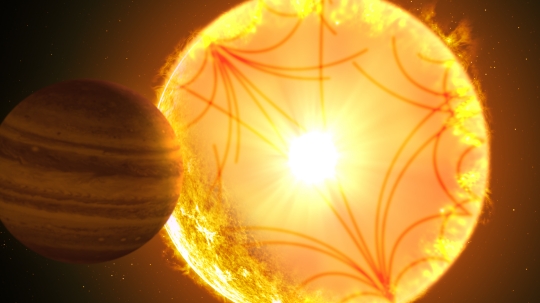
Image: Artist’s concept of a Kepler-1658-like system. Sound waves propagating through the stellar interior were used to characterize the star and the planet. Kepler-1658b, orbiting with a period of just 3.8 days, was the first exoplanet candidate discovered by Kepler nearly 10 years ago. Credit: Gabriel Perez Diaz/Instituto de Astrofísica de Canarias.
This is an interesting find for more than its significance as the first Kepler exoplanet. We know of few planets orbiting stars of this class, a deficit not yet understood. From the paper:
Systems like KOI 4.01 are interesting because giant planets at short orbital periods (P < 100 days) are rare around subgiant stars (e.g. Johnson et al. 2007, 2010; Reffert et al. 2015; Lillo-Box et al. 2016; Veras 2016), although the reason for this is still a topic of debate. On one hand, this may be related to the stellar mass. Subgiant host stars are thought to be more massive than main sequence stars targeted for planet detection. A higher mass could shorten the lifetime of the protoplanetary disk and lead to fewer short-period giant planets orbiting these type of stars (e.g. Burkert & Ida 2007; Kretke et al. 2009). Other authors have suggested that subgiants have fewer short-period planets because these objects may get destroyed by tidal evolution, which is likely stronger for more evolved stars (e.g. Villaver & Livio 2009; Schlaufman & Winn 2013). Distinguishing between those scenarios is further complicated by the fact that it is challenging to derive stellar masses of evolved stars (Lloyd 2011, 2013; Johnson et al. 2013; Ghezzi et al. 2018).
Thus Kepler-186b is a useful outlier that helps us put constraints on what happens as planets approach a death spiral into their star. And another exoplanet mission may provide a useful cross-check:
The Kepler field will be observed by the Transiting Exoplanet Survey Satellite (TESS; Ricker et al. 2015) in mid-2019. Extending the baseline of transit observations to over a decade for Kepler-1658 will allow for a stronger constraint on orbital period decay in more evolved systems. Extrapolating our period decay analysis to the time Kepler-1658 would be observed by TESS would rule out another order of magnitude for the tidal quality factor in subgiant stars.
The paper is Chontos et al., “The Curious Case of KOI 4: Confirming Kepler’s First Exoplanet Detection,” accepted at the Astronomical Journal (preprint).

Black Hole Propulsion as Technosignature
When he was considering white dwarfs and neutron stars in the context of what he called ‘gravitational machines,’ Freeman Dyson became intrigued by the fate of a neutron star binary. He calculated in his paper of the same name (citation below) that gradual loss of energy through gravitational radiation would bring the two neutron stars together, creating a gravitational wave event of the sort that has since been observed. Long before LIGO, Dyson was talking about gravitational wave detection instruments that could track the ‘gravitational flash.’
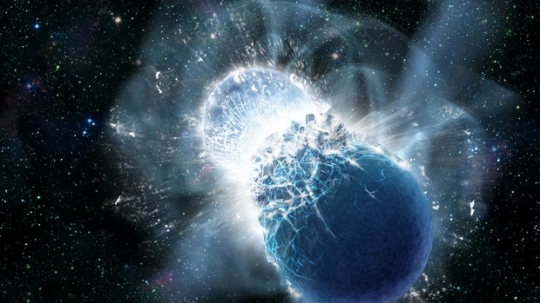
Image: Artist conception of the moment two neutron stars collide. Credit: LIGO / Caltech / MIT.
Observables of this kind, if we could figure out how to do it (and we subsequently have) fascinated Dyson, who was in this era (early 1960s) working out his ideas on Dyson spheres and the capabilities of advanced civilizations. As to the problematic merger of neutron stars in a ‘machine,’ he naturally wondered whether astrophysical evidence of manipulations of these would flag the presence of such cultures, noting that “…it would be surprising if a technologically advanced species could not find a way to design a nonradiating gravitational machine, and so to exploit the much higher velocities which neutron stars in principle make possible.”
He goes on in the conclusion to the “Gravitational Engines” paper to say this: “In any search for evidences of technologically advanced societies in the universe, an investigation of anomalously intense sources of gravitational radiation ought to be included.”
Searching for unusual astrophysical activity is part of what would emerge as ‘Dysonian SETI,’ or in our current parlance, the search for ‘technosignatures.’ It’s no surprise that since he discusses using binary black holes as the venue for his laser-based gravity assist, David Kipping should also be thinking along these lines. If the number of black holes in the galaxy were large enough to support a network of transportation hubs using binary black holes, what would be the telltale sign of its presence? Or would it be observable in the first place?
Remember the methodology: A spacecraft emits a beam of energy at a black hole that is moving towards it, choosing the angles so that the beam returns to the spacecraft (along the so-called ‘boomerang geodesic’). With the beam making the gravitational flyby rather than the spacecraft, the vehicle can nonetheless exploit the kinetic energy of the black hole for acceleration. Huge objects up to planetary size could be accelerated in such a way, assuming their mass is far smaller than the mass of the black hole. No fuel is spent aboard the spacecraft which, using stored energy from the beam, continues to accelerate up to terminal velocity.
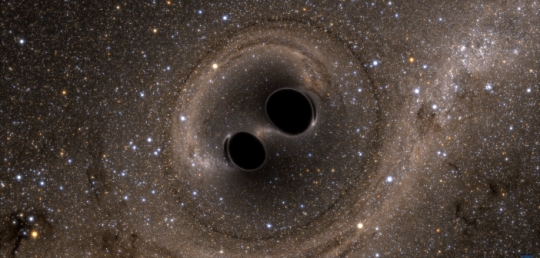
Image: Simulated image of the two merging black holes detected by LIGO, viewed face-on. LIGO’s gravitational-wave detection is the first direct observation of such a merger. Credit: LIGO / AAS Nova.
Kipping likes to talk about the process in terms of a mirror. Because light loops around the approaching black hole and returns to the spacecraft, the black hole exhibits mirror-like behavior. Thus on Earth, if we bounce a ping-pong ball off a mirror, the ball returns to us. But if the mirror is moving towards us quickly, the ball returns faster because it has picked up momentum from the mirror. Light acts the same way, but light cannot return faster than the speed of light. Instead, in gaining momentum from the black hole, the light blueshifts.
We exploit the gain in energy, and we can envision a sufficiently advanced civilization doing the same. If it can reach a black hole binary, it has gained an essentially free source of energy for continued operations in moving objects to relativistic speeds. Operations like these at a black hole binary result in certain effects, so there is a whisper of an observable technosignature.
I discussed the question with Kipping in a recent email exchange. One problem emerges at the outset, for as he writes: “The halo drive is a very efficient system by design and that’s bad news for technosignatures: there’s zero leakage with an idealized system.” But he goes on:
The major effect I considered in the paper is the impact on the black hole binary itself. During departure, one is stealing energy from the black binary, which causes the separation between the two dead stars to shrink slightly via the loss of gravitational potential energy. However, an arriving ship would cancel out this effect by depositing approximately the same energy back into the system during a deceleration maneuver. Despite this averaging effect, there is presumably some time delay between departures and arrivals, and during this interval the black hole binary is forced into a temporarily contracted state. Since the rate of binary merger via gravitational radiation is very sensitive to the binary separation, these short intervals will experience enhanced infall rates. And thus, overall, the binary will merge faster than one should expect naturally. It may be possible to thus search for elevated merger rates than that expected to occur naturally. In addition, if the highway system is not isotropic, certain directions are preferred over others, then the binary will be forced into an eccentric orbit which may also lead to an observational signature.
Tricky business, this, for a black hole binary in this formulation can be used not only for acceleration but deceleration. The latter potentially undoes the distortions caused by the former, though Kipping believes elevated merger rates between the binary pair will persist. Our technosignature, then, could be an elevated binary merger rate and excess binary eccentricity.
I was also interested in directionality — was the spacecraft limited in where it could go? I learned that the halo drive would be most effective when moving in a direction that lies along the plane of the binary orbit. Traveling out of this plane is possible, though it would involve using onboard propellant to attain the correct trajectory. The potential of reaching the speed of the black hole itself remains, but excess stored energy would then need to be applied to an onboard thruster to make the course adjustment. Kipping says he has not run the numbers on this yet, but from the work so far be believes that a spacecraft could work with angles as high as 20 degrees out of the plane of the binary orbit and still reach an acceleration equal to that of the black hole.
For more on the halo drive, remember that Kipping has made available a video that you can access here. The other citations are Kipping, “The Halo Drive: Fuel-free Relativistic Propulsion of Large Masses via Recycled Boomerang Photons,” accepted at the Journal of the British Interplanetary Society (preprint); and Dyson, “Gravitational Machines,” in A.G.W. Cameron, ed., Interstellar Communication, New York: Benjamin Press, 1963, Chapter 12.

